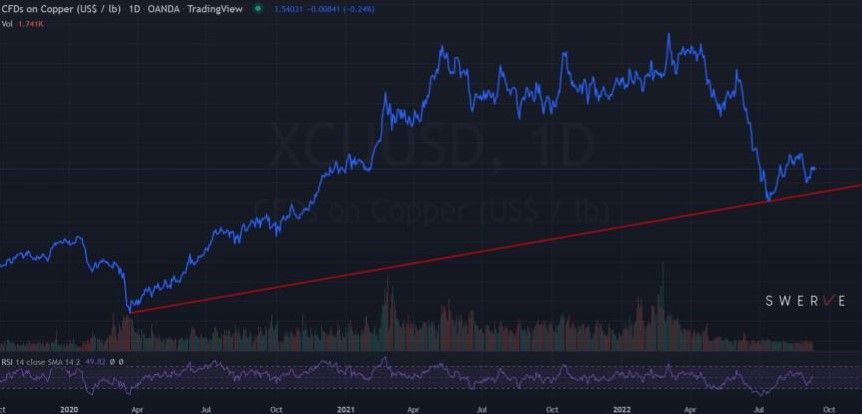The investment case for Copper
Copper is 28% off its recent high as investors are concerned a global recession may affect demand). Here's some key reasons why it may be a buying opportunity.
#copper is 28% off its recent high as investors are concerned a global recession may affect demand (see chart). It may be a buying opportunity, below some key reasons.
First off, history shows that the commodity capital cycle is far more important than the economic cycle in determining the price of copper and other industrial materials. While the latter may drive demand, the former determines long term supply. Investment in copper has been severely depressed for years and there has been no addition of new reserves since 2014. Political instability in Chile (28% of global supply), rising rates and energy prices are additional reasons why increasing investment in the sector will not be forthcoming unless prices rise significantly. Looking at historical data, whenever supply is severely constrained, the real return on copper and other materials is elevated regardless of economic growth. Case in point were the 1930s and the 1970s when copper delivered strong returns precisely because of the lack of investment.
On the demand side, a predictable wave of fiscal stimulus in both China and Europe will be supportive of prices. Once the party congress is out of the way, China will start stimulative policies in earnest to goose a lackluster economy and quell dissent. A loosening of the zero-tolerance policy for C19 is also in the cards as the country follows the lead of other countries and shifts focus to vaccination and treatment. As per Europe, the energy crisis carries the risk of deindustrialization and social unrest. The reaction function, especially in Germany, is likely to be stimulative and capex-positive as the drive to ensure energy security intensifies. All of the above will escalate demand for the metal.
The last and most compelling reason for copper’s investment case, is the need to fight #climatechange and reduce CO2 emissions. Hardly a week goes by without some announcement regarding the replacement of internal combustion engines vehicles with electric ones powered by #renewableenergy . Such plans require large investment in power storage and the expansion of the power grid, both of which are predicated on large quantities of copper. In fact, it is just not clear where all the metal needed for such a transition will come from. According to a study of the Geological Survey of Finland (https://bit.ly/3eKAHSs), the full conversion to #ev transportation would require five times the total amount of known copper reserves. That is to produce just one generation of renewable energy resources which typically have a life cycle of 8 to 25 years.
The long term investment case for copper has never been stronger and its price decline appears to be a consolidation phase in the context of a bullish trend. You can follow me on twitter @pietroventani for more timely comments and updates. Disclosure: Hold all assets mentioned. Not investment advice. Do your own research.